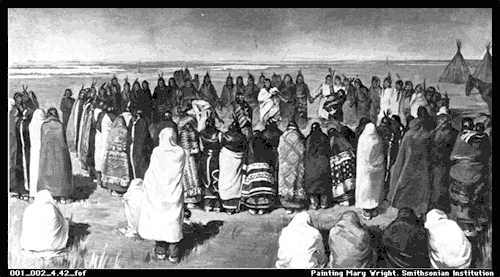The Ghost
Shirt

~~~~~~~~~~~~~~~~~~~~~~~~~~~~~~~~~~~~~~~~~~~~~~~~~~~~~~~~~
This pathfinder should assist
anyone interested in
learning about how and why the Sioux Ghost Shirt changed the
Ghost Dance and
attitudes toward Americans.
By Laney Towle
Primary Sources:
Bear,
Luther
Standing. My People the
Sioux.
Houghton Mifflin Company, 1928.
~This book is a
valuable because it is a primary
source. Standing Bear offers his experience with the
introduction and
development of the Ghost Dance while living at the Pine Ridge
reservation—one
of the most significant sites of the movement. As a Lakota, he
offers his
knowledge on the unique beliefs and interpretations of his
people while still
managing to tackle the topic from a somewhat removed
perspective.
McLaughlin, James, memorandum to the United States government,
November 6, 1890. https://catalog.archives.gov/id/5641589
~The letter, I
assume was written to the United
States government, from a Pine Ridge agent literally lists off
reasons for the
Ghost Dance uprising. Even better, it is from a seemingly
unbiased primary
source. This is effective material to back up an argument
against the U.S.
government and their oppression and unfair treatment of Native
Americans on
reservations during the late 1800s.
Mooney,
James. The
Ghost-dance
Religion and the Sioux Outbreak of 1890.
U.S. Government Printing Office, 1896.
~This
book
is most definitely one of the
most, if not the
most valuable source on the subject
of the Ghost Dance movement, the causes of its outbreak, the
truth behind
Wovoka’s vision, its variations and intricacies between tribes
across the
nation, and the response from whites. I highly recommend this
book to anyone
who is researching anything related to the Ghost Dance. It is
quite lengthy,
but also quite organized and easy to navigate and pinpoint
exactly what you are
researching.
“The
Ghost Dance.” The Wichita
Daily Eagle (Wichita,
KS),
Nov. 22, 1890. http://chroniclingamerica.loc.gov/lccn/sn82014635/1890-11-22/ed-1/seq-1/
~This is a newspaper
article documents an
eyewitness account of the Ghost Dance from the perspective of
a white woman. It
demonstrates how settlers saw and feared the Ghost Dance, and
just how ignorant
they were to the importance it had to the Native Americans.
Secondary Sources:
Agonito, Joseph. Lakota
Portraits: Lives of the Legendary Plains People. Morris
Book Publishing,
2011.
~This book was
immensely helpful in identifying
the physical characteristics of the Ghost shirt and the
meaning behind them. It
also has a ton, I mean a ton, of information about the Sioux
and Lakota. This
context helped me understand the gravity of the whole religion
and the role it
played in the lived of the people of the plains in the late 19th
century.
Andersson, Rani-Henrik. The
Lakota Ghost Dance of 1890. University of Nebraska
Press, 2008.
~This book gives a
great background on the Ghost
Dance and its origins. It has a decently sized section on the
Ghost shirt and
provides many examples and evidence of times where the shirt
influenced
conflict between Natives and Americans, and its role in
battles such as Wounded
Creek (if you can even call that a “battle”).
Coleman,
William S.
E. Voices of Wounded
Knee. University
of Nebraska Press, 2000.
~This book was
advantageous in providing the
detailed account of a former Pine Ridge teacher Mrs. A. A.
Parker. Although you
can find her eyewitness story in other places, I think the
juxtaposition of
sources from both sides during the Ghost Dance movement are
what make it
valuable. If you are looking for firsthand reports and an
in-depth look at the
Wounded Knee Massacre, this is a good place to start.
Hittman, Michael. Wovoka
and the Ghost Dance, Edited by Don Lynch. University of
Nebraska Press,
1997.
~Although I did not
use much information from this
book, I can see it being a good resource for someone studying
Wovoka and his
influences. Views from many historians and well as primary
sources are compiled
in this book to fill in the gaps on how exactly the Ghost
Dance Religion spread
and came to be. There are various adaptations and myths
regarding Wovoka and his
doctrine, but I think this book does a good job in addressing
them.
Nash,
Philleo. Oral
history interview. By Jerry N. Hess. Washington D.C., June 24,
1966. https://www.trumanlibrary.org/oralhist/nash1.htm
~I am not actually
sure what most of this
interview is about, but I do know that is from a trusted
historian for the
Harry S. Truman Library. Philleo Nash has a background in
domestic and war
operations from the country’s earlier days, which makes him a
reliable source
on Indian affairs. I only use one quote from him, but he seems
to be
knowledgeable about just how badly Americans treated Natives
during the height
of the Ghost Dance.
Ostler, Jeffrey. The Lakotas and The Black
Hills: The Struggle for
Sacred Ground. New York, New York: Penguin Group,
2010.
~Although
I
did not use much information from this book either, it clarifying
why the Lakota in particular turned to the Ghost Dance so
quickly, and what
events led to their interpretation. If I were delving into
more about the Black
Hills and their significance, I would have used more from this
book. Maybe next
time you will think before planning a trip to Mount Rushmore.
Utley,
Robert
Marshall. The Last Days
of the Sioux
Nation. Yale University Press, 2004.
~This book is very
useful for anyone wanting to
gain a deeper understanding of the Sioux Nation. It goes into
detail about
their rituals and belief system—many details that we overlook
and undermine as
untrue. I found much of this information interesting and much
more significant
in the context of what happened to the plains Indians during
the Ghost Dance
movement.